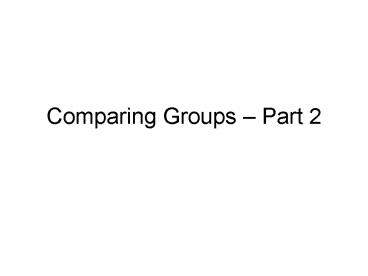Comparing Groups - PowerPoint PPT Presentation
Title:
Comparing Groups
Description:
Load the Generalized Anxiety Disorder (GAD) data. It has Hamilton Rating Scale for Anxiety data for people taking placebo, high or low dose drug. – PowerPoint PPT presentation
Number of Views:29
Avg rating:3.0/5.0
Title: Comparing Groups
1
Comparing Groups Part 2
2
Wilcoxon Signed Rank (again)
3
H0 ? 0 HA ? ? 0
? represents the population mean or median
4
or in colors add up the rank_AbsDiff for the
green negative scores
or in colors add up the rank_AbsDiff for the
blue positive scores
5
or in colors add up the rank_AbsDiff for the
green negative scores
R- 1.5 3 4.5 4.5 7.5 7.57.514.518.5
64.5
or in colors add up the rank_AbsDiff for the
blue positive scores
R 1.5 7.5 11 11 11 14.5 14.5
14.518.518.518.52122 188.5
188.5-64.5/262
6
One-way ANOVA in R
- In the last lecture I gave you a demonstration of
using SAS to conduct a one-way ANOVA. Many
people think that R is a superior tool for doing
analyses like ANOVA. While R is not critical for
simple models like you have seen, it is
invaluable for graphics to describe more
complicated models.
7
R and Anxiety Disorders
- Start R and then type library(Rcmdr)
- Load the dataset using the Import Data option on
the Data menu. - Load the Generalized Anxiety Disorder (GAD) data.
It has Hamilton Rating Scale for Anxiety data
for people taking placebo, high or low dose drug.
8
Summarize the Data
9
Show me the means.
- You want to see if there is a difference in means
in the 3rd variable for the levels of the 2nd
variable. You can request the mean plot
10
The Plot of the Design
I really like boxplots to see the variability
around these means.
11
Set Factor Order
12
Side-by-side Boxplot
13
Boxplot Reordered
14
I want means.
Gad lt- na.omit(Gad) plot.design(Gad,
c(2,3)) attach(Gad) thePlot (boxplot(HAMADOSEG
RP, ylab"HAMA", xlab"DOSEGRP")) where
seq(thePlotn) theMeans tapply(HAMA, DOSEGRP,
mean) points(where, theMeans, col "red", pch
18)
15
Testing for Differences
- Once the data is set with the placebo group as
the baseline, it is easy to ask for tests for the
differences vs. the baseline level.
16
(No Transcript)
17
General Linear Models
- It is important for you to know that ANOVAs are
more than stand-alone analyses that are not
related to modeling. ANOVA fits into a class of
statistics called General Linear Models. They are
well implemented in R and Rcmdr.
18
(No Transcript)
19
Checking the Model
- With the working model you can get lots of
summary information, including diagnostic plots.
20
More Advanced Contrasts
- There is a plethora of methods for dealing with
multiple comparisons. You can search CRAN for
specific methods you see in textbooks. For
example, Walker uses Dunnetts T test for
contrasting the placebo vs. the other levels. - I start search CRAN with RSiteSearch(blah)
21
Nasty code.
- I eventually found the method implemented in a
package called multcomp - library(multcomp)
- gad.aov aov(HAMA DOSEGRP, data Gad)
- summary(glht(gad.aov, linfct mcp(DOSEGRP"Dunnet
t"))) - confint(glht(gad.aov, linfct mcp(DOSEGRP"Dunnet
t")))
22
(No Transcript)
23
Two-Way ANOVA
- When you have two or more predictors, you want to
know if the variables impact the outcome means by
themselves and also if they interact. If
variables interact, it means that together they
do things to the outcome variable beyond what you
would expect from looking at each variable alone.
For example, smoking and eating too much both
hurt longevity but the combination of the two
factors may not be as bad as expected or the
combination may be especially lethal.
24
Anemia
- People with Cervical (C), Prostate(P) or
Colorectal (R) cancers with chemotherapy-induced
anemia were treated either with a drug or placebo
and the changes in their hemoglobin levels were
assessed. The question of interest is, does the
drug reduce anemia?
25
Box Plots of Course
- With code or R commander get boxplots for the
levels of the predictors
26
Design Plots
- You have analysis variables in columns 1, 2 and
4. So specify the design plot like this
27
Interaction Plots
- In addition to the main effects for the
predictors, you want to see if the drug behaves
differently in the people with the three
different cancer groups. Perhaps it helps
increase hemoglobin in one group and decreases it
another.
Type your outcome variable last.
28
- It looks like there are differences between the
cancer types and the drug seems to increase the
hemoglobin relative to the placebo.
29
Modeling
Anova with a capital A is part of the car package
30
Results
To turn off the stuff, type this code before
you model options(show.signif.starsFALSE)
31
ANOVA as a Model
- You can build this ANOVA as a linear model.
32
used for nesting y A/B y A AB y A B
in A
interaction only
main effect and interaction
Set interaction limits (ABC) 2 is equal
to ABC - ABC
Main effect
Remove an explanatory effect.
33
(No Transcript)
34
(No Transcript)
35
SAS EG example
- See the parallel information in the SAS EG
project.































